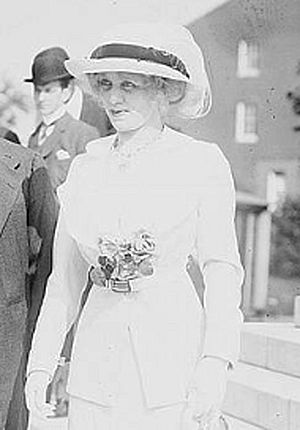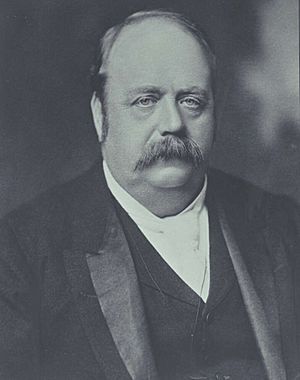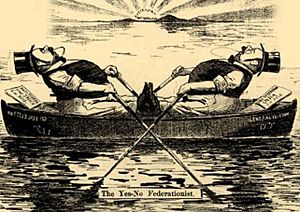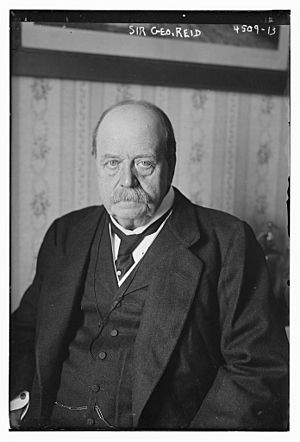George Reid facts for kids
Quick facts for kids
George Reid
|
|
|---|---|

Reid in 1915
|
|
| 4th Prime Minister of Australia | |
| In office 18 August 1904 – 5 July 1905 |
|
| Monarch | Edward VII |
| Governor-General | Lord Northcote |
| Preceded by | Chris Watson |
| Succeeded by | Alfred Deakin |
| 1st Leader of the Opposition | |
| In office 19 May 1901 – 17 August 1904 |
|
| Prime Minister | Edmund Barton Alfred Deakin Chris Watson |
| Preceded by | New position |
| Succeeded by | Chris Watson |
| In office 7 July 1905 – 16 November 1908 |
|
| Prime Minister | Alfred Deakin Andrew Fisher |
| Preceded by | Chris Watson |
| Succeeded by | Joseph Cook |
| 12th Premier of New South Wales | |
| In office 3 August 1894 – 13 September 1899 |
|
| Monarch | Victoria |
| Governor | Sir Robert Duff Lord Hampden |
| Preceded by | George Dibbs |
| Succeeded by | William Lyne |
| Leader of the Free Trade Party | |
| In office 18 November 1891 – 16 November 1908 |
|
| Deputy | William McMillan Dugald Thomson Joseph Cook |
| Preceded by | Henry Parkes |
| Succeeded by | Joseph Cook |
| High Commissioner to the United Kingdom | |
| In office 1 January 1910 – 1 January 1916 |
|
| Preceded by | New position |
| Succeeded by | Andrew Fisher |
| Member of the Australian Parliament for East Sydney |
|
| In office 29 March 1901 – 18 August 1903 |
|
| Preceded by | Division created |
| In office 4 September 1903 – 24 December 1909 |
|
| Succeeded by | John West |
| Member of the New South Wales Parliament for East Sydney |
|
| In office 14 December 1880 – 3 August 1884 |
|
| Preceded by | John Davies |
| Succeeded by | Sydney Burdekin |
| In office 2 March 1887 – 3 August 1894 |
|
| Preceded by | George Griffiths |
| Succeeded by | District Abolished |
| Member of the New South Wales Parliament for Sydney-King |
|
| In office 3 August 1894 – 30 March 1901 |
|
| Preceded by | Constituency Created |
| Succeeded by | Ernest Broughton |
| Member of the House of Commons for St George's, Hanover Square |
|
| In office 11 January 1916 – 12 September 1918 |
|
| Preceded by | Sír Alexander Henderson |
| Succeeded by | Sir Newton Moore |
| Personal details | |
| Born | 25 February 1845 Johnstone, Renfrewshire, Scotland |
| Died | 12 September 1918 (aged 73) London, England |
| Resting place | Putney Vale Cemetery 51°26′26″N 0°14′21″W / 51.440426°N 0.239237°W |
| Political party | None (before 1887) Free Trade (1887–1909) Liberal (1909–1910) Unionist (after 1913) |
| Spouses |
Florence Brumby
(m. 1891; wid. 1918) |
| Relations | Anne Fairbairn (granddaughter) |
| Children | 3 |
| Parents |
|
| Education | Scotch College |
| Profession | Civil servant, barrister, diplomat, politician |
Sir George Houston Reid (born 25 February 1845 – died 12 September 1918) was an important Australian politician. He served as the fourth Prime Minister of Australia from 1904 to 1905. Before that, he was the Premier of New South Wales from 1894 to 1899. He also led the Free Trade Party for many years.
George Reid was born in Scotland and moved to Australia with his family when he was young. They lived in Melbourne and then Sydney. He left school at 13 to work as a clerk. Later, he joined the New South Wales government service. He became a lawyer and wrote books about liberalism and free trade. In 1880, he became a member of the New South Wales Legislative Assembly.
From 1883 to 1884, Reid was a minister in the New South Wales government. He joined the Free Trade Party in 1887 and became its leader in 1891. He became Premier of New South Wales in 1894 and stayed in that role for five years. He made many important changes, like reforms to government services and money matters. He also supported the idea of federation, which was about joining the Australian colonies into one country. He helped write the Constitution of Australia. In 1901, he was elected to the new Federal Parliament.
After federation, Reid became Australia's first Leader of the Opposition. He became Prime Minister in August 1904, leading a government that didn't have a clear majority. His government passed an important law about industrial relations. He left office in July 1905. Later, he became Australia's first High Commissioner in London in 1910. He was even elected to the British Parliament in 1916. He passed away in London in 1918.
Contents
Early Life and Education
George Reid was born in Johnstone, Scotland, on 25 February 1845. He was one of seven children. His father, John Reid, was a minister.
In 1845, his family moved to Liverpool, England. They faced financial difficulties, so his father decided to move the family to Australia. George arrived in Melbourne in May 1852.
He went to school at the Melbourne Academy, now called Scotch College. He studied classical subjects like Greek. At about 13, his family moved to Sydney, and he left school. He started working as a junior clerk. When he was 15, he joined a debating society to practice public speaking.
Starting a Career in Public Service
In 1864, Reid began working for the New South Wales government. He started as an assistant accountant. He was promoted several times, eventually becoming head of the Attorney-General's Department in 1878.
In 1876, he started studying law. He became a barrister in 1879. This allowed him to earn enough money to pursue a career in politics, as politicians were not paid at that time.
Reid also became known for writing about important issues. In 1875, he published Five Essays on Free Trade. In 1878, the government published his book New South Wales, the Mother Colony of the Australians for people in Europe.
Entering Politics
Reid was known for his quick wit and entertaining speeches. People would come to his election meetings as if they were going to a show.
In 1880, Reid was elected to the New South Wales Legislative Assembly for East Sydney. At first, he focused on his legal work. In 1883, he became the Minister of Public Instruction. During his 14 months in this role, he helped pass a new Education Act. This law led to the creation of the first government high schools and technical schools.
In 1884, Reid lost his seat in parliament due to a technical issue. He was re-elected in 1885. He strongly supported free trade. When Henry Parkes formed a free trade government in 1887, Reid refused to join his team. He did not get along with Parkes personally. Reid believed that members of parliament should not be paid, so he donated his salary back to the government. By 1898, he was a leading lawyer in Sydney and was made a Queen's Counsel.
Premier of New South Wales
In 1891, Henry Parkes stepped down as leader of the Free Trade Party. George Reid was chosen to lead the party. In the same year, he married Florence (Flora) Ann Brumby.
At the 1894 election, Reid promised to introduce a free trade system with direct taxes. His party won a big victory. He then formed his first government. One of his first actions was a new land bill. This bill changed how pastoral land was divided and managed.
Reid also worked to pass new land and income tax laws. The New South Wales Legislative Council (the upper house of parliament) initially rejected these laws. After a new election, Reid eventually succeeded in passing them. He also made important changes to how public money was managed and how the civil service worked. He passed laws about public health, factories, and mining. In his five years as Premier, he achieved many reforms.
Role in Federation
George Reid supported the idea of federation, which was the process of uniting the Australian colonies into one nation. However, his political rival, Edmund Barton, was the main leader of the federation campaign. Reid had some concerns about the draft constitution, especially about the power of the Senate.
In 1898, Reid gave a famous speech in Sydney. He said he would look at the constitution "with the deliberate impartiality of a judge." After his long speech, people were still unsure if he fully supported it. He said he felt it was his duty to vote for the bill, but he would not tell others how to vote. This earned him the nickname "Yes-No Reid."
The first vote on the constitution in New South Wales passed, but it didn't get enough votes to be approved. Reid then worked to get more benefits for New South Wales in the constitution. In the second vote, federation was approved in New South Wales.
In September 1899, Reid's government lost a vote in parliament and he was no longer Premier. By this time, Reid had become very large and had a distinctive moustache and monocle. Despite his humorous public image, he was a very clever politician.
Federal Politics
Leader of the Opposition (1901–1904)
In 1901, Reid was elected to the first Federal Parliament as the Member for East Sydney. His Free Trade Party won many seats, but the Labor Party supported the Protectionist government led by Edmund Barton. This meant Reid became Australia's first Leader of the Opposition. This role suited his strong debating style.
In 1903, Reid resigned from parliament and ran again in a special election to highlight an issue about electoral districts. He won back his seat. This was a rare event in Australian political history.
Prime Minister (1904–1905)
In August 1904, the government led by Chris Watson resigned. George Reid then became the Prime Minister of Australia. He was the first person who had been a state premier to become Prime Minister.
Reid's government did not have a majority of seats in parliament. He knew his time as Prime Minister would be short. His government passed the important Commonwealth Conciliation and Arbitration Act 1904, which helped manage disagreements between workers and employers. In July 1905, the other parties joined together to vote his government out of office.
Leader of the Opposition (1905–1908)
After being Prime Minister, Reid became Leader of the Opposition again. He tried to change the political system to have two main groups: Labor and non-Labor. Before the 1906 election, he even changed his party's name to the Anti-Socialist Party.
Reid wanted to create a clear divide in Australian politics, similar to the Westminster system in Britain. His campaign led to his party and the Labor Party winning the same number of seats in the 1906 election. This helped set the stage for the future of Australian politics.
In 1908, Reid resigned as party leader. He did not agree with the idea of merging his party with the Protectionists to form the Commonwealth Liberal Party. He resigned from Parliament in December 1909.
Later Life and Legacy
In 1910, George Reid was appointed as Australia's first High Commissioner in London. This meant he was Australia's top representative in the United Kingdom.
He was very popular in Britain. In 1916, after his term as High Commissioner ended, he was elected to the House of Commons of the United Kingdom (the British Parliament). He represented the area of St George, Hanover Square, as a Unionist politician. He spoke out in support of the war effort.
Sir George Reid passed away suddenly in London on 12 September 1918, at the age of 73. He was survived by his wife, Flora, and their three children. His wife became Dame Flora Reid in 1917. He is buried in Putney Vale Cemetery in London.
Even though he had a funny public image, George Reid was a very smart and effective politician. He made many important changes in New South Wales and played a key role in the early years of Australia's federal government.
Honours
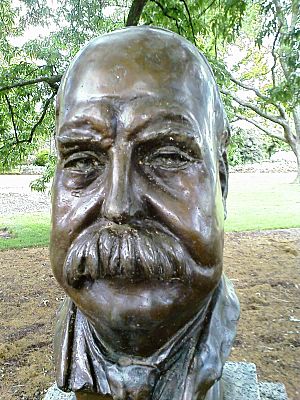
In 1897, Oxford University gave Reid an honorary degree. He was also made a member of the Privy Council in 1904. He received two high honours from the British Crown: a Knight Grand Cross of the Order of St Michael and St George in 1911 and a Knight Grand Cross of the Order of the Bath in 1916.
In 1969, Australia Post honoured him with a postage stamp featuring his picture.
Works
- The Australian Commonwealth and her relation to the British Empire (address, 1912)
Images for kids
See also
 In Spanish: George Reid para niños
In Spanish: George Reid para niños



